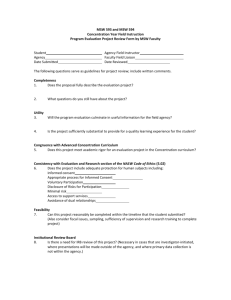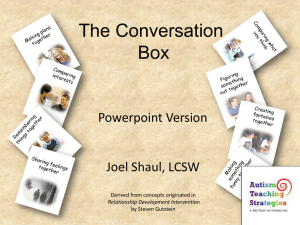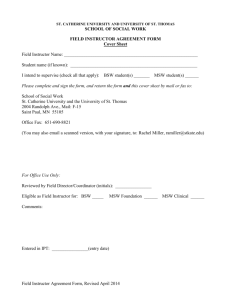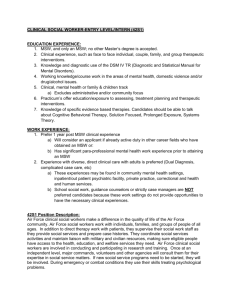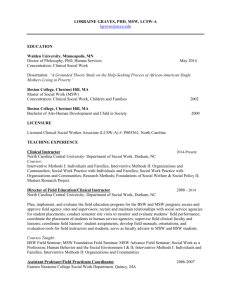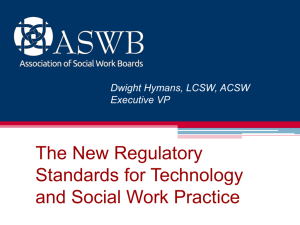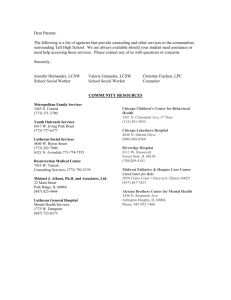Department of Social Work Fall 2009 Field Instructor Orientation and
advertisement
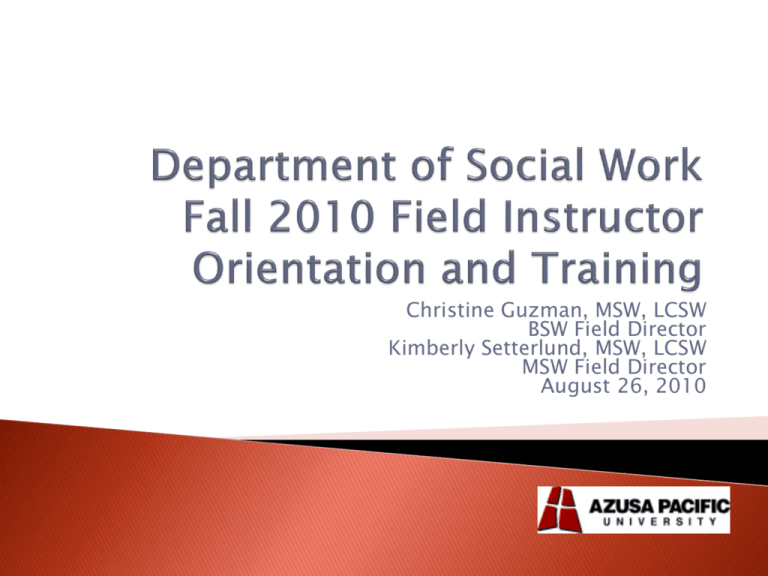
Christine Guzman, MSW, LCSW BSW Field Director Kimberly Setterlund, MSW, LCSW MSW Field Director August 26, 2010 Develop a working knowledge of the APU BSW/MSW field education requirements Be familiar with effective supervision and training strategies Utilize practical applications for building a strong field internship program at your agency Apply field training materials in preparation for your students in the 2010-2011 year Mary Rawlings, Ph.D., LCSW ◦ BSW Program Director/ ◦ Social Work Dept. Chair Sally Alonzo Bell, Ph.D., LCSW ◦ Full Professor Barbara Johnson, MSW,LCSW ◦ Assistant Professor Deb Baker, MSW ◦ Assistant Professor Christine Guzman, MSW, LCSW ◦ BSW Field Director Adjunct Faculty Thuy Chen, MSW, LCSW Adjunct Faculty Cathy Miller, MSW, LCSW Adjunct Faculty Jonathan Clark, MSW Adjunct Faculty Support Staff Dana Pinedo Administrative Assistant Jennyfer Martinez Student Worker Katy Tangenberg, Ph.D. Stephen Brown, Ed.D Adjunct Faculty Nicole Arkadie, LCSW ◦ Director, MSW Program ◦ Adjunct Faculty, Field Liaison ◦ MSW Faculty Shayna Neshama, Ph.D. Karen Maynard, MA Cathy Miller, LCSW ◦ MSW Faculty ◦ Student Services Director ◦ Asst. Director of Field Education Kimberly Setterlund, LCSW Olivia Sevilla, LCSW Adjunct Faculty, Field Liaison Adjunct Faculty, Field Liaison Thuy Chen, LCSW Josefina Sierra, LCSW Adjunct Faculty George Taylor, LCSW Adjunct Faculty, Field Liaison ◦ Director of Field Education ◦ MSW Faculty Maria Carmichael, LCSW Support Staff Lucinda Adam ◦ Administrative Assistant Azusa Unified School District DCFS Sunrise Senior Living Pacific Clinics Foothill Family Services Hillview Acres San Bernardino Public Defenders Office Salvation Army Foothill Presbyterian Hospital Canyon Ridge Hospital Family Solutions David & Margaret Youth & Family Services Santa Anita Family Services Santa Fe High School (WUSD) Azusa Police Department Unity Center San Gabriel Regional Center Whittier Hills Health Care Center Aegis Medical Systems, Inc. Alliance For Children's Rights Anaheim Union High School District Atherton Baptist Home Azusa Unified School District Baldwin Park USD Tri Cities Head Start Bilingual Family Counseling Services Carolyn E. Wylie Center Catholic Charities Administrative Office Chinatown Service Center Community Counseling Center -APU County of Orange Social Services Agency David and Margaret Home Davita Dialysis Chino Davita Dialysis Pomona Davita Fontana Department of Children and Family Services (Glendora) Family Solutions Collaborative Green Dot Public Schools Clinical Services Hillsides Children Services Human Options, Inc. Huntington Hospital, Della Martin Outpatient Program LA Co. Probation Dept., Probation Intern Initiative/Making It Through Little Tokyo Service Center Los Angeles House of Ruth Maryvale Residential Tx Ctr. Mission Hospital St. Joseph Health System Family Resource Center Olive Crest Treatment Centers Dept Corrections & Rehab., Div. of Juvenile Justice, SYCRCC Norwalk Downtown Women's Center East Valley Community Health Center Eastlake Youth Services Ettie Lee Youth and Family Services Exceptional Children's Foundation Los Angeles Family Promise East San Fernando Valley Family Service Long Beach/ Aspiranet Optimist Youth Homes and Family Services-FFA Pacific Clinics Bonita Family Center Pacific Clinics Pasadena Mental Health Center (Five Acres) Pasadena Public Health Department, Andrew Escajeda Clinic, HIV/AIDS Services Pasadena Unified School District Phoenix Houses of Los Angeles, Inc. Placentia-Yorba Linda USD (Valadez Middle School) Riverside County DMH Riverside County, DPSS, APS Salvation Army, So Cal Division Salvation Army- Pasadena San Bernardino Co. Public Defender's Office San Fernando Valley Community Mental Health Santa Anita Family Services Senior Care Network, Huntington Hospital Serenity Infant Care Homes Silverado Senior Living Newport Mesa Silverlake Medical Center Sylmar Health and Rehabilitation Vitas Hospice Covina West End Family Counseling NortonFisher Child & Family Center Whittier Union HS District Includes: APU Mission Statement History of APU BSW Mission Statement MSW Program Mission Statement MSW Concentrations The Department of Social Work at Azusa Pacific University received initial accreditation from the Council on Social Work Education in 1982. Reaccreditation was successfully reinstated in 1990, 1998 and 2006. The program has a strong and diverse generalist BSW program with approximately 115 majors. The MSW Program, admitted the first cohort in fall of 2008, with approximately 70 students. Full-time and part-time options as well as Clinical Practice with Individuals and Families and Community Practice and Partnerships are program concentration options. The Program is currently in candidacy for full accreditation scheduled for 2011. Emphasis on NASW Code of Ethics Students learn to balance faith, ethics and values in a professional setting Q: Will APU students try to evangelize to the clients and staff at the agency? A: APU students, like students in a nonfaith based university, are held to the same standards and are expected to abide by the NASW Code of Ethics. Students should be using appropriate boundaries in classroom and field settings. If a student does try to evangelize to a client, this is an important boundary issue to be discussed in supervision. Accepted majors: Seniors entering field: 109 women 6 men 115 36 ---------------------Asian Black Caucasian Latino Native American Other/Mixed 7% 7% 53% 19% 1% 6% F/T 2nd year students F/T Advanced Standing students P/T students (1st year field) F/T 1st year students Total in Field: Total Enrolled: Male Female 11% 91% 25 12 20 33 90 137 New Students Asian Blacks Caucasian Hispanic Native Amer. Other # % 10 17 45 52 1 12 137 7 12 33 38 1 9 100% 1. 2. 3. First time Field Instructor or Preceptor Veteran Field Instructor or Preceptor Faculty 33% 1 33% 2 33% 3 Education Policy and Accreditation Standards (EPAS) of the Council on Social Work Education: Accreditation Standard 2.1—Field Education—sets standards for the use of field education as an integral part of the MSW program. Defines the minimum number of hours required at bachelor’s and master’s level. Mandates that orientation and field instructor training be provided to agency-based field instructors. (2008 EPAS, pg 9-10) www.cswe.org Field Education is now considered the signature pedagogy. Field Education is the capstone of the social work education experience Students are develop skills through experiential learning in a supervised field setting Focus turns from acquisition to application of knowledge (classroom to field) Students learn to successfully integrate theory into practice Upon completion, students should be ready to begin social work practice within an agency setting. To facilitate positive and challenging experiential learning in a supervised field setting. To partner with skilled, experienced, and motivated social work practitioners who love to teach To train students in evidence-based practice methods consistent with current trends To train competent advanced social work practitioners To contribute to the workforce in the field of social work To promote the integration of faith and social work practice Practice Theories Acquisition of knowledge (Classroom) Law and Ethics Assessment & Interviewing Integration Macro Interventions Crisis Intervention Application of knowledge (Field Setting) Interventions & Treatment Planning It sets the tone for a positive field experience It alleviates fear and anxiety, common emotions for students new to social work When a formal orientation is not provided, students waste agency time trying to find the information on their own, leaving less time for learning Students are made to feel welcome at the agency Plan before student arrives: ◦ Physical location –where will the student work? ◦ Communicate with other staff re: intern roles ◦ Ensure paperwork is taken care of Conduct tour of agency Schedule brief presentations by other staff Develop an orientation packet (Handout 2A – Agency Orientation Quiz) How do you prepare your agency and/or staff for your students’ arrival? What do you provide that is a unique aspect of the orientation? Who is involved in developing the field orientation packet? Who is involved in the orientation? How long is your orientation? Important Policies and Procedures Agency Description Identification (how will students be referred) Confidentiality Safety Issues Agency Jargon Making Referrals The Supervisory Relationship Providing a Safe Learning Environment On-site security, local law enforcement contact information Provide emergency contact numbers Abuse reporting numbers Chain of command Home visit protocol Safety in the office Dealing with violent or potential violent individuals Dealing with suicidal individuals Sexual Harassment Training HIPAA/PHI and Documentation Standards Blood borne Pathogen Training Safety in the Workplace Professional Conduct in the Workplace Which of the following means the most to you? Elvis joins the Army. Jimi Hendrix dies MTV debuts. Kurt Cobain dies. Your answer, of course, depends on your age—or more specifically, on the generation you belong to. While pop music milestones may not seem all that important, the sum total of experiences, ideas and values shared by people of different generations makes for a melting pot of work approaches and priorities. The Traditionalists/Silent/Great Generation (1933-1945) The Baby Boomers (1946-1964) Generation X (1965-1977) The Millennial Generation (19781998) Characteristics: Hardworking Loyal Work within the system/submissive Technically challenged Traditional Have knowledge of legacy to share Implications: Prefer face to face communication Your word is your bond and you mean what you say Good team players You do not want your time wasted Characteristics: Optimistic Independent Competitive (in the workplace) Focused on personal accomplishment Work-centric ◦ Created the 60-80 hour work week Implications: Expect for Generation X and Y should pay their dues Prefer to be thorough when answering questions Prefer options and flexibility Characteristics Independent Resilient High adaptability/ flexible Feedback is important “I don’t need someone looking over my shoulder” Implications: Email is a primary tool for communication Two-way feedback is valued Informal communication style is preferred As an X’er the more information, the better 75 million members The most child-centric time in our history Technically literate Team oriented, band together socially Multi-task with high energy Expect structure in the workplace Celebrate diversity Socially conscience Teamwork Technology Structure Entertainment and excitement Experiential activities Resource: Millennials Rising: The Next Great Generation (2000) Gives an account why they are hopeful for our future with this generation. Compares Millennials to the greatest generation Explains cycling of generations “G I generation” or our Millennials are confident, but unskilled: Present them with challenges with structure: ◦ Provide mentors Silent generation and a millennial are a nice pair ◦ Respond well to personal attention Thrive in individual supervision/mentoring ◦ Give deadlines planners ◦ Work well interactively Groups and pairs ◦ Mentor in groups ◦ Break down goals into steps ◦ Offer necessary resources to complete the task ◦ Encourage them to use each other as a resource ◦ Utilize technology – this is their strength! (Thielfoldt & Scheef, 2003) Deadline reminders Informal relationships Confidence Want quick responses Personalize outcomes Field implications Modeling Reinforcing Educate on the therapeutic process Capitalize on these teaching moments! These include students who have returned to school after extended work experience Part-time students (AKA “working students”) ◦ Characteristics: Extremely responsible Insecurity – needing to prove they are graduate school “material” Juggling multiple responsibilities – work, home & family, school Interns with more experience than field instructor “are they teachable?” Considerations: student openness to teaching, making school/field a priority BSW Students are generally in their early 20s. Have been traditional students Student ages (N=90) 21-24 25-29 30-34 12% (11) 10% (9) 12% (11) 34% (30) 35-40 32% (29) 41-57 MSW Students vs. Field Instructors Talk about the generation you identify with most What adjustments will you make to your supervision style? “Katie,” 20 year old, Caucasian, traditional BSW student “typical millennial” – sheltered, confident, selfcentered, limited life skills, expected to be catered to both in the classroom and in the field. Challenges in supervision – would be late or miss supervision; unprepared for supervision Challenges in field – often late, poor attendance, required a lot of direction, perceived by staff that she was not motivated Strengths – socially likeable, intelligent confident, multi-tasker, international minded Build the foundation for a successful year in field by: ◦ ◦ ◦ ◦ ◦ ◦ ◦ ◦ ◦ ◦ Beginning with an effective orientation Formalize a supervision schedule Discuss hopes and expectations Provide specific expectations for field performance Refer to Learning Agreement to begin goal setting Give immediate feedback when possible Give positive as well as constructive feedback often Make a point of getting to know your student(s) Identify student strengths and challenges in learning Identify your student’s learning styles vs. your own Add up: A______ B______ C______ Each student bring a unique set of needs Similarities exist, Differences exist How to be to a critical thinker in field What thorough case management looks like Focus on agency documentation How to collect data to form an assessment Putting theory into practice ◦ Why we chose this intervention How to use supervision ◦ Knowing what questions to ask ◦ Understanding how to use process recordings How to identify as a professional ◦ With clients ◦ with staff and community Use of authority Council on Social Work Education. (2008). Educational policy and accreditation standards. Retrieved August 21, 2008 from http://www.cswe.org. Dettlaff, A.J. (2003). From Mission to Evaluation. A Field Instructor Training Program. Council on Social Work Education: VA. Howe, Neil and Strauss, William. (2000). Millennials Rising: The Next Great Generation. Vintage Books. New York. Hurtado, S., Sax, L. J., Saenz, V., Harper, C. E., Oseguera, L., Curley, J., Lopez, L., Wolf, D., Arellano, L. (2007). Findings from the 2005 administration of Your First College Year. Los Angeles: Higher Education Research Institute. Strauss, William. (2001.) The millennials come to campus. About Campus, Vol. 6 Issue 3, p.6, 7p. Retrieved August 17, 2006 from http://plinks.ebscohost.com/ehost/detail?hid=1&sid=474c91b78da2-4d91-bc9d-9989954cedfb%40sessionmgr4 Tucker, Patrick.(2006). Teaching the millennial generation. Futurist, Vol. 40 Issue 3, p7-7. Retrieved August 17. 2006 from http://plinks.ebscohost.com/ehost/pdf?vid=2&hid=1&sid=4b7b1e5a0e90-4596-a8bf-33c616e0e97d%40sessionmgr103 Kaye, B., Scheef, D., & Thielfoldt, D. (2003). “Engaging the generations” in human resources in the 21st century. Eds. Effron, R. Grandossy & M. Goldsmith. Proviter, McGlynn, A. (2005). Teaching millennials, our newest cultural cohort. Education Digest, 71(4) pp 12-16. Retrieved June 5, 2008 from http://plinks.ebscohost.com/ehost/detail?hid=102&sid=d2eacc5540c0-4952-a941-68611d5684d6%40sessionmgr4 Raines, C (2002). “Managing Millennials”. Connecting generations: the sourcebook. Retrieved June 11, 2010 from http://www.generationsatwork.com/articles/millennials.htm Saenz, V. B. & Barrera, D. S. (2007). Findings from the 2005 college student survey (Css): National Aggregates Los Angeles: Higher Education Institute.
